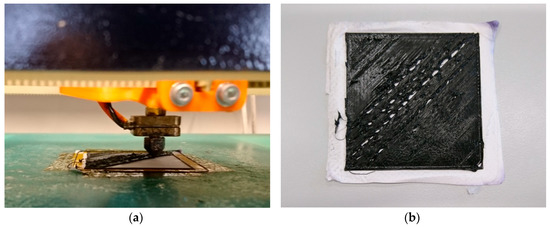In the recently published ‘Stabilization of Electrospun Nanofiber Mats Used for Filters by 3D Printing,’ international researchers explore the technology of electrospinning in detail, attempting to refine production of nanofiber mats used in applications requiring large areas of material like medical wound dressing, biotechnological procedures, and catalyzers.
Nanofiber mats may require added stability, often possible through the following:
- Heat pressing
- Ultrasonic welding of several other mats
- Coating of mats
- Laminating
- Crosslinking fibers
- Embedding nanofiber mats into textile composites
As the study of mechanical properties and improvement thereof continues to be a central focus in 3D printing, research like this also targets better ways to increase stability. For this study, samples were evaluated on a simple Orcabot XXL FDM 3D printer, using PLA as the material.

3D printing with fused deposition modeling (FDM) technology on a polyacrylonitrile (PAN) nanofiber mat. The printing polymer PLA (here green) is delivered as a filament into the nozzle in a molten state and placed on the nanofiber mat.
During this research, the authors discovered that to 3D print on nanofiber mats with success, the distance between the nozzle and the nanofiber mat had to be controlled precisely:
“On the one hand, the nanofiber mat breaks at once if the distance is too small or the nozzle even touches the mat, which is opposite to 3D printing on woven, warp knitted, or weft knitted fabrics, where it can be advantageous in terms of adhesion for pressing the filament into the textile by printing “below” the textile surface,” stated the researchers. “On the other hand, if the distance is too large, the contact between both materials is lost, resulting in a very uneven surface.”
During testing, nanofiber mats were glued onto the printing bed, with varying degrees in temperature. They discovered that adhesion was ‘strongly supported’ at a temperature of 60 °C or higher, while advancing to 80 °C caused ‘severe problems.’
“Since heating the printing bed did not show any advantage, the results depicted here were gained with the printing bed at room temperature,” stated the researchers.
The team also noted that it would seem adhesion problems occur when the nozzle is set ‘slightly too high’ due to electrostatic repulsion between printing materials and the mat. Soaking and drying the sample in water or a soapy solution did support relaxation, however, leading the research team to deem such treatment advantageous and beneficial to any 3D printing with nanofiber mats.

3D printing squares of dimensions 40 mm × 40 mm on nanofiber mats previously dipped in soap water: (a) rough surface for a too large distance between nanofiber mat and printing nozzle; (b) 3D printed layer with uneven surface and even several not closed areas near the diagonal, i.e., along the longest lines, due to a too large distance between nozzle and nanofiber mat.

Confocal laser scanning microscope (CLSM) images of polyacrylonitrile (PAN) nanofiber mats: (a) pure PAN (electrospun with 80 kV), (b) pure PAN (electrospun with 80 kV) after printing on the other side of the nanofiber mat, (c) carbonized PAN (electrospun with 50 kV), and (d) carbonized PAN (electrospun with 50 kV) after printing on the other side of the nanofiber mat.
“Optical and chemical examinations revealed that the nanofiber mats were not measurably modified by the 3D printing process. Contact angle examinations did not show significant differences in hydrophilicity, comparing the pure nanofiber mat and the composite surface,” concluded the researchers.
“While in this first proof-of-principle, a full layer was 3D printed on the nanofiber mats, as the composites could be used in filter applications with the liquid flow parallel to them, future experiments have to be conducted to investigate the possibility to print open mesh-like structures on nanofiber mats to also enable utilization in filters through which the liquid flows.”
Researchers continue to study methods in electrospinning, from bone regeneration to bioprinting, wound repair, and more. What do you think of this news? Let us know your thoughts! Join the discussion of this and other 3D printing topics at 3DPrintBoard.com.

Electrospun nanofiber mat in Martindale abrasion test holder, (a) before the test, (b) after 10 cycles in dry state, and (c) after one cycle in wet state.
Subscribe to Our Email Newsletter
Stay up-to-date on all the latest news from the 3D printing industry and receive information and offers from third party vendors.
You May Also Like
Gorilla Sports GE’s First 3D Printed Titanium Cast
How do you help a gorilla with a broken arm? Sounds like the start of a bad joke a zookeeper might tell, but it’s an actual dilemma recently faced by...
Nylon 3D Printed Parts Made More Functional with Coatings & Colors
Parts 3D printed from polyamide (PA, Nylon) 12 using powder bed fusion (PBF) are a mainstay in the additive manufacturing (AM) industry. While post-finishing processes have improved the porosity of...
$25M to Back Sintavia’s Largest Expansion of Metal 3D Printing Capacity Since 2019
Sintavia, the digital manufacturing company specializing in mission-critical parts for strategic sectors, announced a $25 million investment to increase its production capacity, the largest expansion to its operations since 2019....
Velo3D Initiates Public Offering in a Bid to Strengthen Financial Foundations and Drive Future Growth
Velo3D (NYSE: VLD) has been among a number of publicly traded 3D printing firms that have attempted to weather the current macroeconomic climate. After posting a challenging financial report for 2023,...































